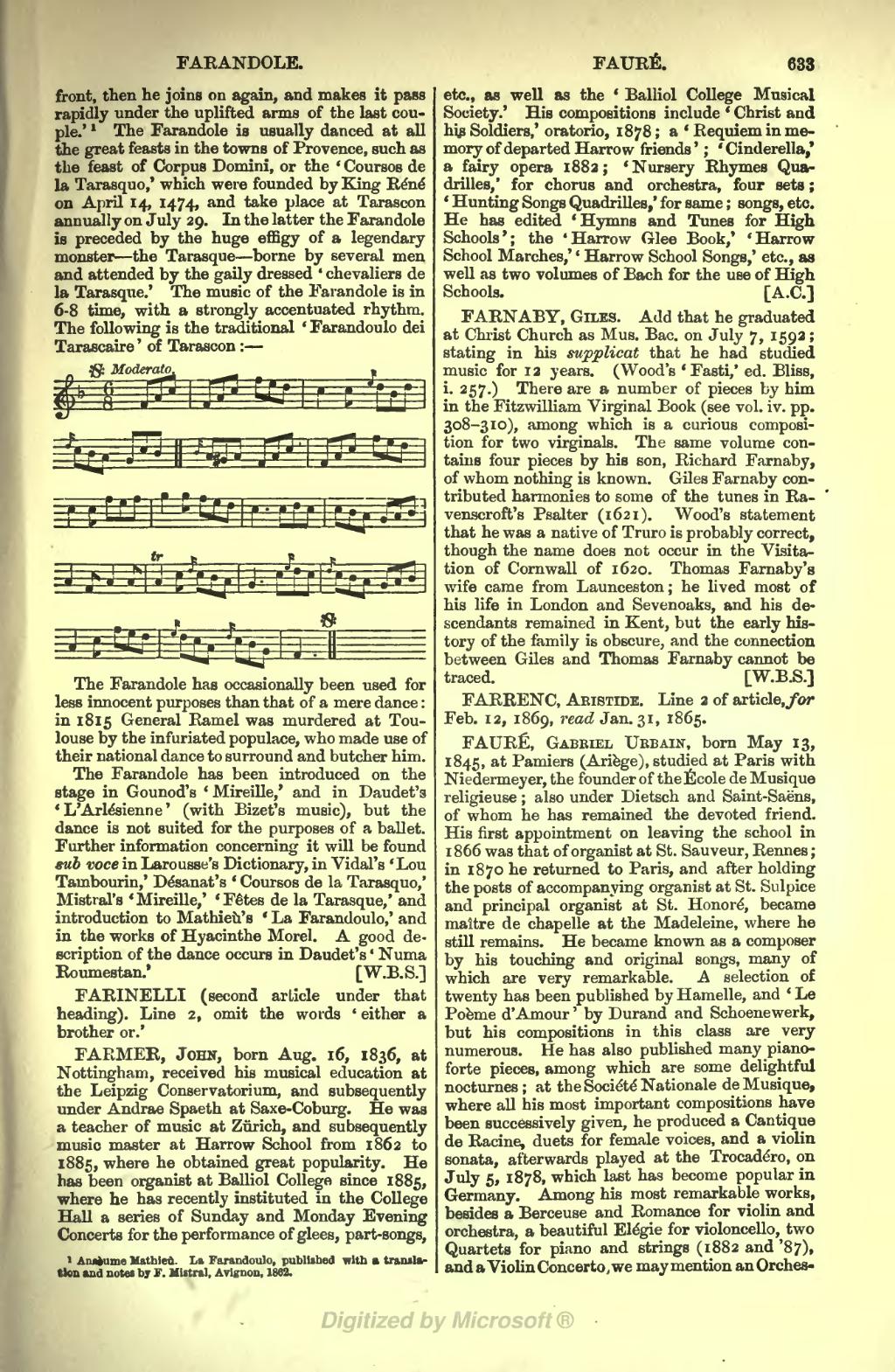front, then he joins on again, and makes it pass rapidly under the uplifted arms of the last couple.'[1] The Farandole is usually danced at all the great feasts in the towns of Provence, such as the feast of Corpus Domini, or the 'Coursos de la Tarasquo,' which were founded by King Réné on April 14, 1474, and take place at Tarascon annually on July 29. In the latter the Farandole is preceded by the huge effigy of a legendary monster—the Tarasque—borne by several men and attended by the gaily dressed 'chevaliers de la Tarasque.' The music of the Farandole is in 6-8 time, with a strongly accentuated rhythm. The following is the traditional 'Farandoulo dei Tarascaire' of Tarascon:—

The Farandole has occasionally been used for less innocent purposes than that of a mere dance: in 1815 General Ramel was murdered at Toulouse by the infuriated populace, who made use of their national dance to surround and butcher him.
The Farandole has been introduced on the stage in Gounod's 'Mireille,' and in Daudet's 'L'Arlésienne' (with Bizet's music), but the dance is not suited for the purposes of a ballet. Further information concerning it will be found sub voce in Larousse's Dictionary, in Vidal's 'Lou Tambourin,' Désanat's 'Coursos de la Tarasquo,' Mistral's 'Mireille,' 'Fêtes de la Tarasque,' and introduction to Mathieù's 'La Farandoulo,' and in the works of Hyacinthe Morel. A good description of the dance occurs in Daudet's 'Numa Roumestan.'
[ W. B. S. ]
FARINELLI (second article under that heading). Line 2, omit the words 'either a brother or.'
FARMER, John, born Aug. 16, 1836, at Nottingham, received his musical education at the Leipzig Conservatorium, and subsequently under Andrae Spaeth at Saxe-Coburg. He was a teacher of music at Zürich, and subsequently music master at Harrow School from 1862 to 1885, where he obtained great popularity. He has been organist at Balliol College since 1885, where he has recently instituted in the College Hall a series of Sunday and Monday Evening Concerts for the performance of glees, part-songs, etc., as well as the 'Balliol College Musical Society.' His compositions include 'Christ and his Soldiers,' oratorio, 1878; a 'Requiem in memory of departed Harrow friends'; 'Cinderella,' a fairy opera 1882; 'Nursery Rhymes Quadrilles,' for chorus and orchestra, four sets; 'Hunting Songs Quadrilles,' for same; songs, etc. He has edited 'Hymns and Tunes for High Schools'; the 'Harrow Glee Book,' 'Harrow School Marches,' 'Harrow School Songs,' etc., as well as two volumes of Bach for the use of High Schools.
[ A. C. ]
FARNABY, Giles. Add that he graduated at Christ Church as Mus. Bac. on July 7, 1592; stating in his supplicat that he had studied music for 12 years. (Wood's 'Fasti,' ed. Bliss, i. 257.) There are a number of pieces by him in the Fitzwilliam Virginal Book (see vol. iv. pp. 308–310), among which is a curious composition for two virginals. The same volume contains four pieces by his son, Richard Farnaby, of whom nothing is known. Giles Farnaby contributed harmonies to some of the tunes in Ravenscroft's Psalter (1621). Wood's statement that he was a native of Truro is probably correct, though the name does not occur in the Visitation of Cornwall of 1620. Thomas Farnaby's wife came from Launceston; he lived most of his life in London and Sevenoaks, and his descendants remained in Kent, but the early history of the family is obscure, and the connection between Giles and Thomas Farnaby cannot be traced.
[ W. B. S. ]
FARRENC, Aristide. Line 2 of article, for Feb. 12, 1869, read Jan. 31, 1865.
FAURÉ, Gabriel Urbain, born May 13, 1845, at Pamiers (Ariège), studied at Paris with Niedermeyer, the founder of the École de Musique religieuse; also under Dietsch and Saint-Saëns, of whom he has remained the devoted friend. His first appointment on leaving the school in 1866 was that of organist at St. Sauveur, Rennes; in 1870 he returned to Paris, and after holding the posts of accompanying organist at St. Sulpice and principal organist at St. Honoré, became maître de chapelle at the Madeleine, where he still remains. He became known as a composer by his touching and original songs, many of which are very remarkable. A selection of twenty has been published by Hamelle, and 'Le Poème d'Amour' by Durand and Schoenewerk, but his compositions in this class are very numerous. He has also published many pianoforte pieces, among which are some delightful nocturnes; at the Société Nationale de Musique, where all his most important compositions have been successively given, he produced a Cantique de Racine, duets for female voices, and a violin sonata, afterwards played at the Trocadéro, on July 5, 1878, which last has become popular in Germany. Among his most remarkable works, besides a Berceuse and Romance for violin and orchestra, a beautiful Elégie for violoncello, two Quartets for piano and strings (1882 and '87), and a Violin Concerto, we may mention an Orches-
- ↑ Ansèume Mathieù. La Farandoulo, published with a translation and notes by F. Mistral, Avignon, 1862.

